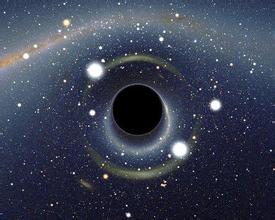(单词翻译:单击)
听力文本
This is Scientific American — 60-Second Science. I'm Christopher Intagliata.
Got a minute?
Black holes got their name because light can't escape them, beyond a certain radius, called the event horizon. But in 1974 Stephen Hawking proposed that quantum effects at the event horizon might cause black holes to be...not completely black.
"Hawking said that pairs of particles should be created at the event horizon." Jeff Steinhauer, a physicist at the Israel Institute of Technology. "One particle exits the black hole and travels away, perhaps to Earth, and the other particle falls into the black hole."
Ideally, we could just study those exiting particles...which make up the so-called Hawking radiation. But that signal is too weak. We can't see it against the universe's background radiation. So Steinhauer built a model of a black hole instead. Which traps not photons, but phonons—think of them as sound particles—and it traps of using a gas of rubidium atoms, flowing faster than the speed of sound.
"And that means that phonons, particles of sound, trying to travel against the flow are not able to go forward. They get swept back by the flow. It's like someone trying to swim against a river which is flowing faster than they can swim. And the phonon trying to go against the flow is analogous to a photon trying to escape a black hole."

Steinhauer doesn't actually pipe sound particles into the device. He doesn't need to. He merely created the conditions under which quantum effects predict their appearance. "So the two swimmers can come into existence simultaneously without anybody supplying energy to create them."
He ran the test 4,600 times—the equivalent of six days—and took pictures of the results. And indeed, he saw a correlation between particles emanating into and out of the model black hole…an experimental demonstration of Hawking radiation. The results appear in Nature Physics.
Steinhauer also determined that the partner particles had a quantum connection, called entanglement...which could help theorists investigating the information paradox. "So there's the question of where does information go, if one throws it into a black hole?" This study can't answer that. But, he says, "it helps give hints, to direct physicists towards the new laws of physics, whatever they might be."
Thanks for listening for Scientific American — 60-Second Science Science. I'm Christopher Intagliata.
参考译文
这里是科学美国人——60秒科学。我是克里斯托弗·因塔利亚塔。
黑洞得名的原因是光无法逃脱一个特定的界面——视界。但是1974年,史蒂芬·霍金提出,视界里的量子效应,可以使黑洞不是完全的“黑暗”。
“霍金说,视界可以产生成对的粒子。”以色列理工学院的物理学家杰夫·施泰因豪尔说道。“一个粒子远离黑洞逃逸,可能进入地球,而另一个粒子则被黑洞吞噬。”
理想情况下,我们可以研究这些逃逸粒子……这些粒子构成了“霍金辐射”这一理论。但是信号太弱了。在宇宙辐射背景下,我们根本看不到它发出的辐射。所以施泰因豪尔构建了一个黑洞模型。这个黑洞模型不仅能吸收光子,还能吸收声子——姑且认为声子就是声音粒子——模型使用的是铷原子气体,铷原子的运动速度比声音的速度要快。
“这意味着声子无法对抗铷原子继续前进。它们会被气流阻回。这就仿佛有人想要逆流而上,但是河水的速度快于他的游泳速度。声子试图逆流逃离就如同光子想要逃离黑洞一样。”
施泰因豪尔实际上并没有用管道将这些粒子输入设备。因为他根本不用这样做。他只是营造了产生量子效应的环境。“所以,两个‘游泳者'可以同时存在,而不需要任何人提供能量。”
施泰因豪尔用6天的时间进行4600次测试,并将测试结果拍照保存。他发现了逃逸粒子和被吸入黑洞粒子之间的关系……这相当于“霍金辐射”理论的演示实验。该研究结果发表在《自然物理》杂志上。
施泰因豪尔发现成对粒子之间存在量子关联,这被称为“量子纠缠”,这种关联可以帮助理论学家研究信息悖论。“所以现在的问题是,如果一个粒子被吸入黑洞,那么信息将去往何处?”这项研究不能回答这个问题。但是施泰因豪尔表示,“该研究给我们提供指导物理学家研究新物理学定律的线索。”
谢谢大家收听科学美国人——60秒科学。我是克里斯托弗·因塔利亚塔。
译文为可可英语翻译,未经授权请勿转载!


